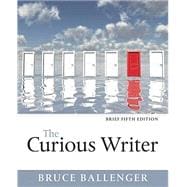NOTE: You are purchasing a standalone product; MyWritingLab does not come packaged with this content. If you would like to purchase both the physical text and MyWritingLab search for:
Package consists of:
- 0133944131 / 9780133944136 MyWritingLab with Pearson eText — Access Card
- 013394414X / 9780133944143 MyWritingLab with Pearson eText — Inside Star Sticker
- 0134080386 / 9780134080383 The Curious Writer, Brief Edition








